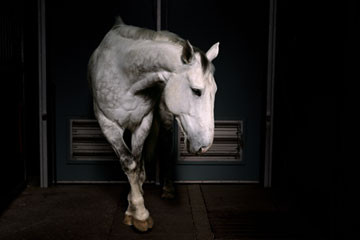
Horses can lapse into apparent depression when they lose a companion.
(3 of 6)
There's no shortage of behaviors that fit that description. By most measures, the animals that seem to experience death in the most humanlike way are not the ones that are genetically closest to us--the great apes--but elephants. The literature has long been rife with reports of the funeral rites and almost reverential treatment of remains that occur among elephant herds. British zoologist Iain Douglas-Hamilton was particularly struck by the 2003 death of an African elephant known as Eleanor at a national park in Kenya.
Eleanor was the matriarch of her herd and had given birth less than six months earlier. Suffering from an illness, she collapsed in the presence of another female. That elephant, known as Grace, trumpeted, nudged Eleanor and tried to push her up with her tusks. As Eleanor died the next morning, another female, Maui, approached and stood over her, rocking and examining her. For a full week, Eleanor's baby and the females of the herd visited the remains. They kept coming after park workers had removed Eleanor's tusks to discourage poachers; they came too after scavengers had begun to eat the remains. The baby nuzzled her mother's body and tried to nurse from the other young calves. But the milk never came, and her mother never moved--and the baby soon died too.
"I see so clearly the emotional ripple effects of Eleanor's death," says King. "I wouldn't want to say every single elephant who approaches Eleanor is grieving: some may be simply curious. But the extreme distress Douglas-Hamilton describes telegraphs to us across species lines."
The great apes approach things differently. One reason may be that their superior brainpower allows them to grasp the permanence and inevitability of death in a way other animals don't. Primatologist Frans de Waal, director of Emory University's Living Links Center, points to a scene he observed when a troop of bonobos encountered a poisonous snake known as a Gaboon viper. The bonobos approached the viper only closely enough to poke it with a stick until a female seized it and flung it onto the ground, killing it. In a blink, the feared animal became a benign object, with young bonobos even examining its fangs and wearing it like a reptilian lei.
"None of them expected it to come back to life," de Waal says. "Dead is dead."
That awareness, which hits grieving humans in terrible waves of existential permanence over the course of months, makes things harder for apes too. At the Burgers' Zoo in Arnhem, the Netherlands, an adolescent female chimpanzee named Oortje contracted an infection that was not responding to medication. One afternoon when the animals were in their indoor enclosure, Oortje seemed particularly sickly, and another female approached her and stared into her eyes, then broke out into screams and began pounding herself on the chest. Oortje tried to vocalize back but toppled over and died. A scream erupted from another chimp, and then all the animals in the large enclosure grew completely still.
